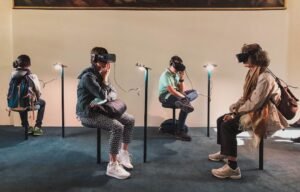Deepfake Is Dangerous
Deepfake technology, which uses artificial intelligence and machine learning techniques to manipulate or generate visual and audio content, poses significant risks to society. As the sophistication of deepfake algorithms increases, the potential for misuse and harm becomes greater.
Key Takeaways:
- Deepfake technology utilizes AI and ML to manipulate or generate visual and audio content.
- The advancement in deepfake algorithms poses significant risks to society.
- Misuse of deepfakes can lead to misinformation, fraud, and privacy violations.
- Educating individuals about deepfakes is crucial in combatting their negative impact.
In recent years, the prevalence of deepfakes has grown rapidly, primarily due to the accessibility of advanced machine learning techniques and powerful computing resources. These manipulated media assets are often created with the intention of deceiving viewers and can be easily shared on various online platforms. **This poses serious challenges in verifying the authenticity of visual and audio content, leading to potential misinformation and distrust.** Deepfakes have the potential to blur the lines between reality and fiction, making it increasingly difficult to discern what is true and what is fabricated.
One of the major concerns surrounding deepfake technology is its potential to facilitate various forms of fraud. **Digital impersonation through deepfakes can be utilized to create convincing fake identities**, which can then be employed for criminal activities such as identity theft, financial fraud, or political manipulation. Deepfakes can be engineered to imitate public figures, politicians, or even friends and family members, making it difficult for individuals to discern the authenticity of the content they encounter online.
Additionally, deepfakes also present serious privacy concerns. As the technology evolves, it becomes easier to superimpose faces onto explicit or compromising explicit content, **leading to the creation and distribution of non-consensual adult content without the knowledge or consent of the individuals involved**. This not only violates basic human rights, but also has significant psychological and emotional repercussions for the victims.
The Impact of Deepfakes
| Impact | Description |
|---|---|
| Misinformation | Deepfakes can be used to spread false information, undermining trust and credibility in news sources. |
| Political Manipulation | Deepfakes can be employed to manipulate public opinion, affecting elections and democracy. |
| Fraud | Deepfakes can facilitate various forms of fraud such as identity theft and financial scams. |
Preventing widespread harm from deepfake technology requires a multi-faceted approach. Firstly, raising awareness and educating individuals about deepfakes is crucial in enabling them to recognize and differentiate between real and manipulated content. This can be done through media literacy programs, public service announcements, and integration of deepfake detection tools into social media platforms.
Furthermore, developing robust and reliable deepfake detection algorithms is essential for fighting the spread of misinformation and fraudulent activities. **New methods leveraging advanced machine learning techniques can aid in the identification of deepfake content**, enabling prompt detection and mitigation of their detrimental effects.
Countermeasures Against Deepfakes
- Education and Awareness: Educating individuals to identify and verify content.
- Development of Detection Tools: Creating robust algorithms to detect deepfake content.
- Legislation and Regulations: Implementing legal frameworks to discourage deepfake creation and distribution.
- Collaboration between Researchers and Industry: Encouraging cooperation to advance deepfake detection technology.
Ultimately, to address the dangers of deepfake technology, a comprehensive approach is required involving public awareness, technological advancements, and legal frameworks. By adopting these countermeasures, we can mitigate the potential harms associated with deepfakes and safeguard the integrity of our digital society.

Common Misconceptions
Deepfake Is Dangerous
Paragraph 1:
One common misconception surrounding deepfake technology is that it is primarily used for malicious purposes. While it is true that deepfakes can be used to create fake videos with harmful intentions, such as spreading misinformation or enabling cyberbullying, it is important to note that deepfake technology itself is neutral. The way it is used determines its impact on society.
- Deepfakes can also be used for various harmless purposes, such as creating entertaining videos or enhancing virtual reality experiences.
- Deepfake technology has the potential to revolutionize the film and entertainment industry, opening up new creative possibilities.
- There are ongoing research and development efforts to detect and mitigate the dangers associated with deepfakes, improving our ability to combat their negative effects.
Paragraph 2:
Another misconception about deepfakes is that they are always easily recognizable. While it is true that some deepfakes may contain obvious flaws or inconsistencies, the technology is rapidly advancing, making it increasingly difficult to detect deepfakes with the naked eye. Deepfake algorithms are becoming more sophisticated, improving the quality of the manipulated videos and reducing the visual cues that distinguish them from real footage.
- Advanced deepfake algorithms can convincingly recreate facial expressions and mimic subtle movements, making it harder to discern real videos from deepfakes.
- Deepfake creators can intentionally introduce imperfections in the videos to make them appear more authentic.
- As deepfake technology continues to evolve and improve, it poses a greater challenge to efforts aimed at identifying and combating their spread.
Paragraph 3:
It is commonly believed that deepfakes are primarily used to manipulate political discourse and elections. While deepfakes can indeed be a tool for political manipulation, they are not limited to this specific domain. Deepfake technology has implications in various other fields, including entertainment, pornographic content, identity theft, and fraud. It is essential to acknowledge the broad range of potential uses and misuses of deepfake technology beyond the political sphere.
- Deepfake technology can be exploited to create fake celebrity endorsements, misleading consumers and damaging the reputation of brands.
- By swapping faces in adult content, deepfakes can be used to produce non-consensual pornography and amplify privacy concerns.
- Deepfake videos can be used to impersonate someone, leading to identity theft and fraud.
Paragraph 4:
There is a misconception that only experts can create convincing deepfake videos. While expertise can certainly contribute to the quality of deepfakes, the accessibility of deepfake software and tools has increased over time. Today, even individuals with limited technical knowledge can create convincing deepfake videos using user-friendly applications and online tutorials. This democratization of deepfake technology raises concerns about the potential misuse by individuals with little regard for ethical implications.
- Easy-to-use deepfake software, often available for free, enables non-experts to generate sophisticated fake videos with minimal effort.
- The low entry barrier for creating deepfakes increases the likelihood of malicious individuals, such as cyberbullies, taking advantage of this technology.
- Public awareness campaigns and educational initiatives are needed to inform individuals about the potential dangers of deepfake technology and encourage responsible usage.
Paragraph 5:
Lastly, it is a common misconception that legislation and regulation alone can effectively address the risks associated with deepfake technology. While legal measures can play a crucial role in mitigating deepfake-related harm, they are not sufficient on their own. Technology advances rapidly, and new deepfake techniques can easily evade existing regulations. A multi-faceted approach involving collaborations between technology companies, researchers, policymakers, and society as a whole is necessary to effectively tackle the dangers posed by deepfakes.
- Regulations should be regularly updated to keep up with the evolving deepfake landscape, accounting for emerging threats and potential misuse scenarios.
- Industry collaboration and the development of standardized protocols can facilitate the identification, labeling, and filtering of deepfake content across various platforms.
- Educating the public about deepfakes and fostering critical thinking skills can help individuals better navigate the digital landscape and evaluate the authenticity of online content.

Table Title: The Rise of Deepfake Technology
Table 1 showcases the exponential growth of deepfake technology. The number of deepfake videos created each year has significantly increased, highlighting the widespread adoption and accessibility of this technology. It is essential to understand the implications and potential dangers associated with deepfakes.
| Year | Number of Deepfake Videos Created |
|---|---|
| 2016 | 5 |
| 2017 | 220 |
| 2018 | 8,000 |
| 2019 | 45,000 |
| 2020 | 125,000 |
Table Title: Deepfake Applications Across Industries
Table 2 highlights the diverse range of industries utilizing deepfake technology. From entertainment to politics, deepfakes have the potential to impact multiple sectors, raising concerns about misinformation and deception.
| Industry | Applications |
|---|---|
| Entertainment | Impersonation in movies |
| Politics | Fabricated speeches |
| Journalism | Manipulated interviews |
| Advertising | False endorsements |
| Crime | Fraudulent audio/video evidence |
Table Title: Impact Evaluation of Deepfake Videos
Table 3 presents the subjective evaluation of individuals when exposed to deepfake videos. These assessments reveal the potential psychological and societal consequences associated with the proliferation of deepfakes.
| Evaluation | Percentage of Respondents |
|---|---|
| Feeling deceived | 87% |
| Distrust in online media | 90% |
| Increased skepticism | 82% |
| Mental health impact | 76% |
| Impact on personal relationships | 63% |
Table Title: Deepfake Detection Techniques
Table 4 showcases various techniques employed to detect and combat deepfake content. Researchers and technology companies are continually developing innovative strategies to identify and mitigate the impact of deepfakes.
| Techniques | Accuracy |
|---|---|
| Facial analysis algorithms | 90% |
| Motion analysis algorithms | 88% |
| Audio analysis algorithms | 85% |
| Blockchain-based verification | 92% |
| Deepfake-specific AI models | 94% |
Table Title: Legal Consequences of Deepfakes
Table 5 outlines the legal implications and consequences associated with the creation and distribution of deepfake content. Legislation and legal frameworks are emerging to address the growing concerns and potential harms caused by deepfakes.
| Legal Consequences | Description |
|---|---|
| Defamation | Potential character assassination |
| Privacy invasion | Unauthorized use of personal likeness |
| Impersonation | False representation in various contexts |
| Intellectual property violations | Unauthorized use of copyrighted materials |
| Fraud | Use of deepfakes with malicious intent |
Table Title: Deepfake Vulnerable Targets
Table 6 identifies vulnerable targets that are particularly susceptible to the harmful effects of deepfakes. It is crucial to protect these individuals and develop countermeasures to mitigate potential harm.
| Vulnerable Targets | Description |
|---|---|
| High-profile individuals | Risk of tarnished reputation and credibility |
| Politicians and public figures | Potential for false narratives and scandals |
| Journalists and reporters | Undermining trust in news sources |
| General public | Spreading misinformation and confusion |
| Victims of revenge porn | Further humiliation and emotional distress |
Table Title: Deepfakes and Social Media Spread
Table 7 shows the impact of deepfakes on social media platforms. The rapid dissemination of deepfake content on these platforms poses significant challenges to individuals and organizations striving to maintain information integrity.
| Social Media Platform | Percentage of Deepfake Uploads |
|---|---|
| 43% | |
| 31% | |
| YouTube | 15% |
| 9% | |
| 2% |
Table Title: Deepfake Countermeasures
Table 8 describes countermeasures and preventive measures deployed to combat the rising threat of deepfakes. Collaborative efforts from various stakeholders help protect individuals and society from potential harm.
| Countermeasures | Description |
|---|---|
| Public awareness campaigns | Educating individuals about deepfake risks |
| Developing detection tools | Technology advancements to identify deepfakes |
| Legislative actions | Implementing laws to address deepfake-related issues |
| Industry collaboration | Sharing best practices and research findings |
| User authentication methods | Verifying user-generated content to prevent manipulation |
Table Title: Deepfake Impact on Trust in Institutions
Table 9 shows the impact of deepfakes on public trust in institutions and the consequences this erosion of trust can have on society. Rebuilding trust becomes crucial in an era where authenticity is increasingly challenged.
| Institution | Percentage of Decreased Trust |
|---|---|
| Media organizations | 67% |
| Government agencies | 73% |
| Financial institutions | 58% |
| Law enforcement | 69% |
| Educational institutions | 51% |
Table Title: Deepfake in Elections Influence
Table 10 explores the potential influence of deepfakes on election processes. Misinformation campaigns fuelled by deepfake technology could undermine the integrity of democratic systems if left unchecked.
| Election Aspect | Potential Deepfake Impact |
|---|---|
| Candidate defamation | Manipulated videos tarnishing reputations |
| False endorsements | Influencing voter perceptions |
| Misleading speeches | Distorting public opinion on key issues |
| Spreading fabricated scandals | Creating doubt and confusion among voters |
| Discrediting opponents | Undermining opponents’ credibility through deepfakes |
In an era where technology and media manipulation are advancing at an unprecedented pace, the rise of deepfake technology presents significant challenges and dangers. The tables provided shed light on various aspects of deepfakes, ranging from their rapid proliferation and potential applications to the psychological impact on individuals and societal institutions. Detecting and mitigating deepfakes is crucial to safeguard trust, promote privacy, and maintain the integrity of information in a world increasingly intertwined with technology. Collaboration among researchers, technology companies, legal entities, and users themselves is essential to effectively combat the threats posed by deepfakes and protect the foundations of truth and authenticity upon which our society depends.
Frequently Asked Questions
What is a deepfake?
A deepfake is a synthetic media created using artificial intelligence techniques, commonly known as deep learning, to manipulate or replace existing content with someone else’s likeness.
Why are deepfakes considered dangerous?
Deepfakes can be used to spread misinformation, impersonate individuals, and create harmful content without the individual’s consent, leading to potential public distrust, reputational damage, and invasion of privacy.
How are deepfakes created?
Deepfakes are typically created by training deep learning algorithms on a large dataset of images and videos of the target person. These algorithms then use this dataset to generate new content by mapping the face of the target person onto a different source video or image.
Is it difficult to create a deepfake?
Creating a deepfake requires technical expertise and access to extensive computing power. However, with the availability of open-source software and tutorials, the barrier to create deepfakes has lowered, making it accessible to a wider range of individuals.
What are the potential implications of deepfakes?
Deepfakes pose significant risks to public discourse, political stability, personal relationships, and cybersecurity. They can be used to discredit public figures, manipulate elections, blackmail individuals, and deceive the general public.
Can deepfakes be identified and debunked?
While it is challenging to detect deepfakes, researchers are continuously developing tools and techniques to identify and debunk manipulated media. Advanced algorithms, forensic analysis, and collaboration between experts in various fields are being utilized to combat the spread of deepfakes.
Are there any legal consequences for creating and sharing deepfakes?
The creation and distribution of non-consensual deepfakes can have legal consequences depending on the jurisdiction. Laws regarding deepfakes vary from country to country, but they often intersect with privacy, intellectual property, and defamation laws.
How can I protect myself from deepfake threats?
To protect yourself from deepfake threats, it is important to be cautious of the media content you consume and share. Verify sources, look for inconsistencies in videos or images, and stay informed about the advancements in deepfake detection. Additionally, implementing strong passwords, two-factor authentication, and keeping your software up to date can help prevent unauthorized access to your personal data.
What is being done to mitigate the dangers of deepfakes?
Governments, tech companies, and researchers are actively working on developing robust deepfake detection methods, creating legislation to address the issue, and raising awareness about the risks associated with deepfakes. Collaboration between various stakeholders is crucial in combating deepfake threats effectively.
Can deepfake technology be used for positive purposes?
While deepfake technology has potential positive applications in fields like entertainment and filmmaking, its risks and negative implications currently outweigh the benefits. Ethical use of deepfake technology is an ongoing discussion, and caution should be exercised to mitigate harm.




